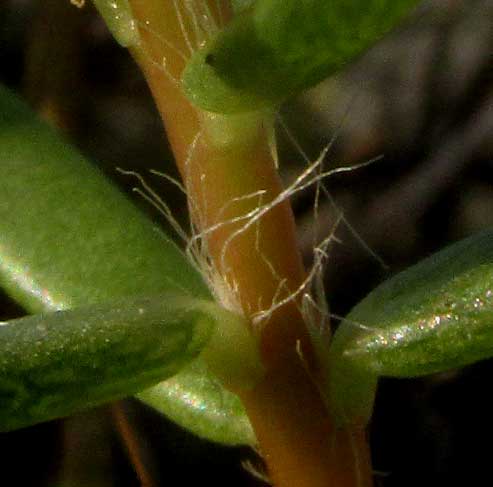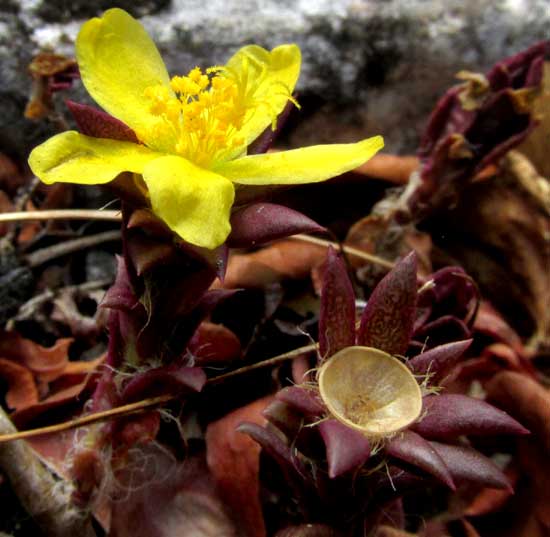Excerpts from Jim Conrad's
Naturalist Newsletter

from the July 19, 2015 Newsletter, an on-the-road edition, from notes taken in Río Lagartos, on the Yucatan Peninsula's northern coast (~N21.60°, ~W88.16°), Yucatán state, MÉXICO
REDSTEM PURSLANE
Once again at dawn on a peaceful Sunday morning out in the mangroves I awoke to find beside my tent a little wildflower bearing a bright blossom that hadn't been open when I'd gone to sleep. The plant was only about 2-1/3 inches tall (6cm) but the yellow blossom was about the size of a fingernail, looking large on such a small plant. At the top of this page you can see it in very thin soil atop limestone.
With such a conspicuous, yellow blossom and succulent leaves, it looks very much like a purslane, but the only purslane I've seen here has been the one that's so good to eat cooked, but it has flat leaves. Maybe this was a narrow-leaved purslane species -- another member of the genus Portulaca. Looking for more Portulaca credentials, I saw that the flower bore many stamens from which a single style atop the ovary branched at its top into several curved stigmas -- exactly as in Portulaca flowers -- as shown below:

Moreover, arising from between the leaves' petioles and the reddish stem were conspicuous white hairs, stiff and long enough to be called trichomes -- a detail I sort of remembered from the purslanes I'd eaten -- as seen below:

Four purslane species are listed for the Yucatan Peninsula, and all four happen to be treated in the Flora of North America, so this species was easy to "key out" as the Redstem Purslane, PORTULACA RUBRICAULIS. It's main field marks -- besides the fact that it's obviously a purslane -- is that its succulent stems are rounded in cross-section, not flat like the common species, its flowers are relatively large, and it has those stiff, white trichomes between the petioles and stem. The species occurs from southern Florida through the Caribbean Area, and in South America.
The Flora of North America says it inhabits coastal beaches and shell mounds. Ours was in a thin crust of soil atop limestone at the mangrove edge, which isn't beach. This caused doubt about the identification until I found Gilberto Ocampo Acosta's published notes about Redstem Purslane, when he describes as occurring throughout the northern Yucatan Peninsula, including well into the interior. His work in Spanish appears in a 2003 edition of ACTA Botánica Mexicana, freely available on the Internet, with maps and keys.
from the June 5, 2016 Newsletter issued from Hacienda Chichen Resort beside Chichén Itzá Ruins; limestone bedrock; elevation ~39m (~128ft), N20.675°, W88.569°; central Yucatán state, MÉXICO
REDSTEM PURSLANE FRUITING
Redstem PUrslane is fruiting here now, as at Río Lagartos turning up in patches of thin soil atop outcropping limestone rock. When Redstem Purslane fruits lose their seeds, tiny little "pixy cups" are left behind, shown below:

A close-up of a flower and left-behind cup is shown below:

I suspect that these cups function the way certain bowl-shaped fungi do: When raindrops splatter into the cups, a fungus's spores are spattered all about, and I'll bet that here when the rainy season's first raindrops fell, lots of Redstem Purslane seeds similarly were splashed into new territory.